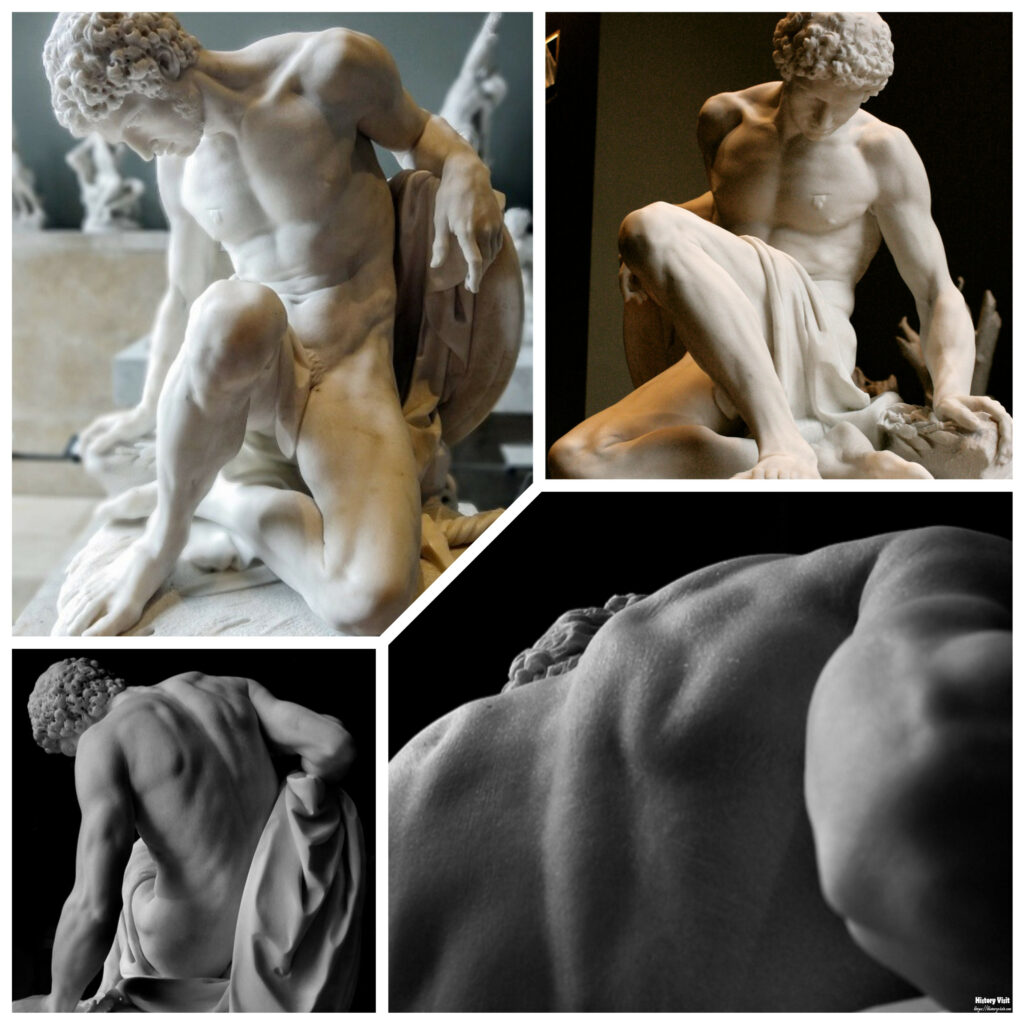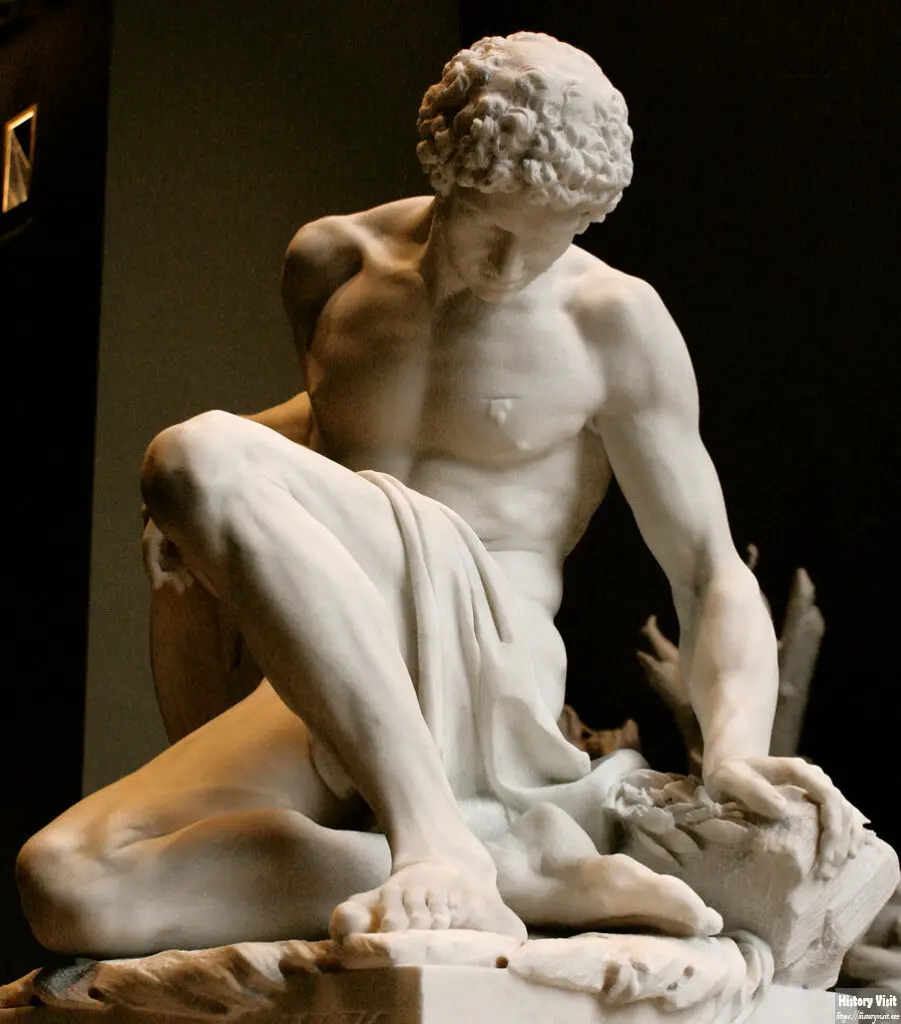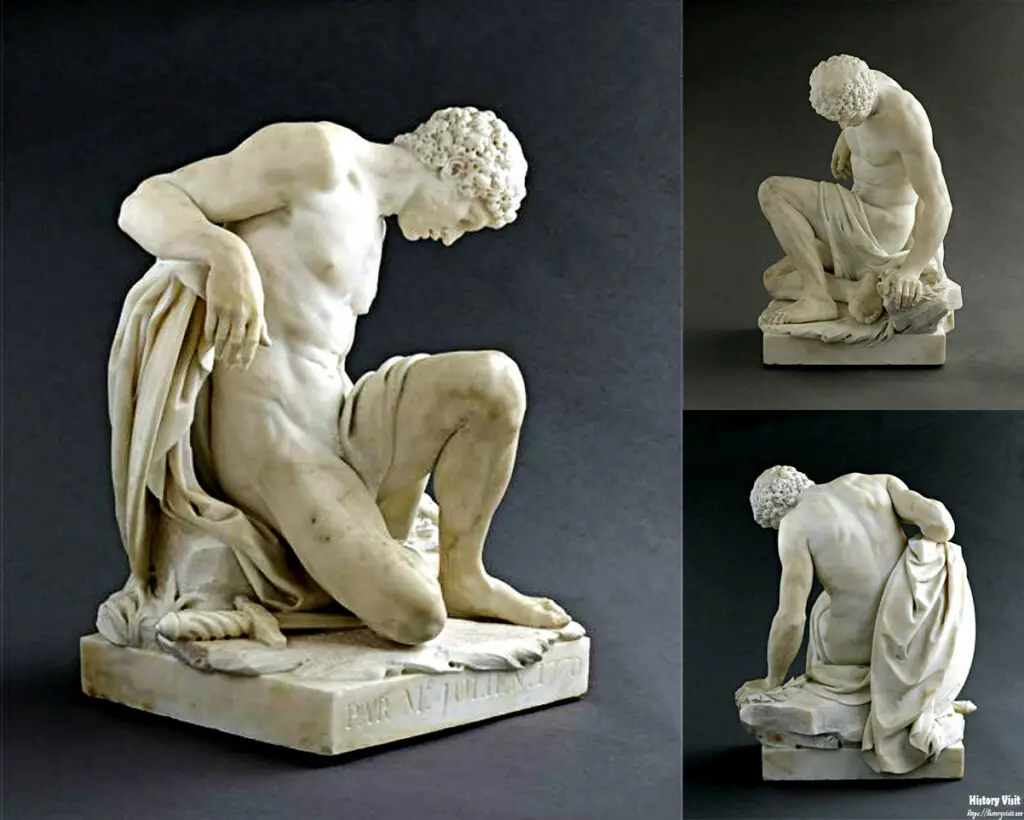The Dying Gladiator Sculpture by Pierre Julien: A Masterpiece of Neoclassical Art

Introduction
Pierre Julien, a luminary of 18th-century French sculpture, made an indelible mark on the Neoclassical art movement with his masterful works. Among his celebrated creations, the “Dying Gladiator” stands out as a quintessential representation of his artistic brilliance and the era’s cultural ideals. This poignant sculpture encapsulates the Neoclassical aesthetic, emphasizing symmetry, simplicity, and the exploration of noble themes drawn from classical antiquity. Through the “Dying Gladiator,” Julien not only showcases his technical prowess but also delves into a profound narrative of human heroism and vulnerability, offering a timeless reflection on the human condition.
The “Dying Gladiator” is a deeply evocative piece that mirrors the period’s fascination with ancient Rome and its complex social phenomena, such as gladiatorial combat. Julien’s sculpture transcends mere historical depiction, capturing the emotional and physical struggles of a gladiator in his final moments. This work exemplifies the Neoclassical ideals of combining precise anatomical detail with expressive emotional content, resulting in a powerful piece that continues to resonate with contemporary audiences. Through this sculpture, Julien invites viewers to contemplate themes of sacrifice, mortality, and heroism, making the “Dying Gladiator” a lasting testament to the enduring power of art to convey profound human truths.
Historical and Artistic Context

The Neoclassical period, spanning the late 18th and early 19th centuries, marked a significant cultural shift in the arts, characterized by a renewed interest in the classical antiquity of Greece and Rome. This era was driven by a desire to return to what were perceived as the pure, timeless ideals of the ancient world, focusing on symmetry, simplicity, and grandeur. Pierre Julien, born in 1731 in Saint-Paulien, France, rose to prominence within this artistic milieu, contributing significantly to the era’s defining aesthetic. Trained at the École des Beaux-Arts in Paris, Julien was profoundly influenced by his studies of classical art and sculpture.
Julien’s “Dying Gladiator,” created in 1779, is a testament to his deep engagement with classical themes. The choice of a gladiator as his subject reflects the period’s fascination with ancient Rome, where gladiatorial combat was both a popular spectacle and a complex social phenomenon. Gladiators, often slaves or prisoners of war, fought in brutal contests for the entertainment of the public, embodying both the glory and the brutality of Roman society. Julien’s sculpture captures this duality, presenting the gladiator as a figure of both physical prowess and profound vulnerability.
The “Dying Gladiator” sculpture also mirrors the broader intellectual currents of the time, particularly the Enlightenment’s emphasis on reason, nature, and humanity. By depicting a moment of human suffering and resignation, Julien aligns with the Enlightenment’s interest in exploring the depths of human emotion and experience. This focus on the individual and their inner life was a departure from the more grandiose and idealized representations of earlier periods, signaling a shift towards a more nuanced and humanistic approach in art.
Furthermore, the Neoclassical period was marked by a reaction against the excesses of the preceding Rococo style, which was characterized by ornate, playful, and often superficial aesthetics. Neoclassicism sought to restore a sense of order, discipline, and moral seriousness to the arts. Julien’s “Dying Gladiator” embodies this ethos, combining a rigorous attention to form and anatomy with a deeply moving emotional resonance. It stands as a powerful example of how Neoclassical artists like Julien sought to balance technical precision with profound expressive content.
Description and Analysis

The “Dying Gladiator” is a masterful representation of the human form in a state of profound distress and resignation. Julien’s sculpture captures the exact moment when the gladiator, severely wounded, is succumbing to his injuries. Seated on a rocky outcrop, the gladiator’s body is slumped forward, his muscles still tensed from the exertions of combat, yet his strength is visibly waning. This pose highlights Julien’s exceptional ability to convey both dynamic motion and the stillness of approaching death.
Julien’s attention to anatomical accuracy is evident in the detailed rendering of the gladiator’s musculature and the realistic depiction of his wounds. Every sinew and muscle is meticulously sculpted, showcasing the physical prowess that defines the gladiator even in his final moments. The wounds, portrayed with striking realism, are a testament to Julien’s dedication to lifelike detail. This anatomical precision not only serves to enhance the visual impact of the sculpture but also underscores the physical toll of the gladiator’s life and the violence he endured.

The facial expression of the gladiator is a poignant element of the sculpture. His furrowed brow and slightly parted lips convey a mixture of pain, exhaustion, and stoic acceptance of his fate. Julien masterfully captures the subtle nuances of emotion, from the grimace of pain to the vacant stare of a man who knows his end is near. This nuanced portrayal of emotion invites viewers to empathize with the gladiator’s plight, bridging the gap between the ancient and the modern by focusing on universal human experiences of suffering and endurance.
The composition of the sculpture, with the gladiator’s head tilted downward and his gaze cast away from the viewer, adds to the sense of isolation and resignation. This deliberate choice of posture and gaze enhances the emotional impact of the piece, drawing the viewer’s attention to the inner world of the dying gladiator. The combination of anatomical precision, expressive detail, and thoughtful composition makes Julien’s “Dying Gladiator” a profound exploration of human strength and fragility, encapsulating the artist’s ability to marry technical skill with deep emotional resonance.
Symbolism and Impact

Beyond its aesthetic appeal, the “Dying Gladiator” carries a deeper symbolic resonance. The gladiator, a figure who fought and often died for the entertainment of others, serves as a metaphor for the broader human condition. His struggle and ultimate demise reflect themes of sacrifice, mortality, and the transient nature of glory. In the context of the 18th century, this symbolism would have resonated deeply with contemporary audiences, who were grappling with questions of personal honor, societal duty, and the fleeting nature of human achievements.
The sculpture also invites contemplation on the nature of heroism. In depicting the gladiator not in the throes of victory but in the quietude of defeat, Julien challenges the traditional heroic narrative. The true heroism of the gladiator lies not in his conquests but in his endurance and dignity in the face of inevitable death. This perspective aligns with the Neoclassical ideal of noble suffering, where greatness is found in one’s ability to endure and maintain virtue amidst adversity. This reinterpretation of heroism reflects a broader cultural shift towards valuing inner strength and moral fortitude over external triumphs.

Moreover, the “Dying Gladiator” serves as a poignant commentary on the human condition and the existential struggles that define it. The sculpture’s focus on the solitary figure of the gladiator, isolated in his final moments, speaks to universal themes of isolation, vulnerability, and the inevitability of death. By highlighting these aspects, Julien’s work transcends its historical context, offering a timeless reflection on the shared human experience. The gladiator’s resigned yet dignified posture becomes a powerful symbol of humanity’s resilience in the face of suffering and mortality.
The emotional depth and symbolic richness of the “Dying Gladiator” have contributed to its lasting impact on the art world and beyond. The sculpture’s ability to evoke profound emotional responses and stimulate philosophical reflection has ensured its place as a significant work of art. It continues to inspire contemporary artists and scholars, demonstrating the enduring power of Neoclassical art to engage with fundamental human concerns and to articulate complex truths about the human experience.
Legacy and Influence

Pierre Julien’s “Dying Gladiator” has had a lasting impact on the art world. It is a celebrated example of Neoclassical sculpture and has influenced countless artists and sculptors who sought to capture the human form with similar emotional depth and technical skill. The sculpture’s meticulous attention to detail and its evocative emotional content have set a high standard for subsequent generations of artists. It serves as a benchmark for the Neoclassical style, illustrating the period’s ideals and its emphasis on the synthesis of form and emotion.
The influence of the “Dying Gladiator” extends beyond its immediate aesthetic impact. It has played a significant role in shaping the discourse around the portrayal of heroism and suffering in art. By presenting a nuanced depiction of a hero in his final moments, Julien’s work challenges viewers to reconsider traditional notions of strength and valor. This reinterpretation has had a profound effect on the way subsequent artists approach similar themes, encouraging a more introspective and empathetic perspective.

Today, the “Dying Gladiator” continues to be admired by art enthusiasts and scholars alike. It stands as a testament to Pierre Julien’s artistic legacy and the enduring power of Neoclassical art to convey profound human truths. The sculpture’s presence in major art collections and its frequent inclusion in discussions of Neoclassical art underline its significance. Its ability to resonate with contemporary audiences attests to its timeless appeal and its capacity to engage with ongoing dialogues about art, history, and human experience.
In conclusion, Pierre Julien’s “Dying Gladiator” is more than just a sculpture; it is a poignant exploration of human strength and vulnerability, a reflection on the nature of heroism, and a masterpiece of Neoclassical artistry. Its enduring legacy is a testament to the skill and vision of one of history’s great sculptors. Through its meticulous craftsmanship and profound emotional depth, the “Dying Gladiator” continues to captivate and inspire, ensuring its place as a seminal work in the canon of Western art.
Conclusion

Pierre Julien’s “Dying Gladiator” remains a striking testament to the enduring power of Neoclassical art. The sculpture’s meticulous detail and evocative emotional depth encapsulate the period’s artistic ideals, while also transcending its historical context to speak to universal themes of human strength, vulnerability, and resilience. By depicting a gladiator in his final moments, Julien challenges traditional heroic narratives, emphasizing the nobility found in suffering and the quiet dignity of facing one’s fate. This nuanced portrayal invites viewers to engage with the sculpture on a deeply emotional and intellectual level, making it a timeless piece that continues to resonate across generations.
The legacy of the “Dying Gladiator” extends far beyond its immediate aesthetic appeal. It has influenced countless artists and shaped the discourse around the depiction of heroism and suffering in art. As a masterpiece of Neoclassical sculpture, it stands as a benchmark for artistic excellence, illustrating the profound capacity of art to capture and reflect the complexities of the human experience. Through its powerful blend of technical precision and emotional resonance, Pierre Julien’s “Dying Gladiator” remains a celebrated work, ensuring Julien’s place among history’s great sculptors and the sculpture’s continued relevance and admiration in the world of art.


